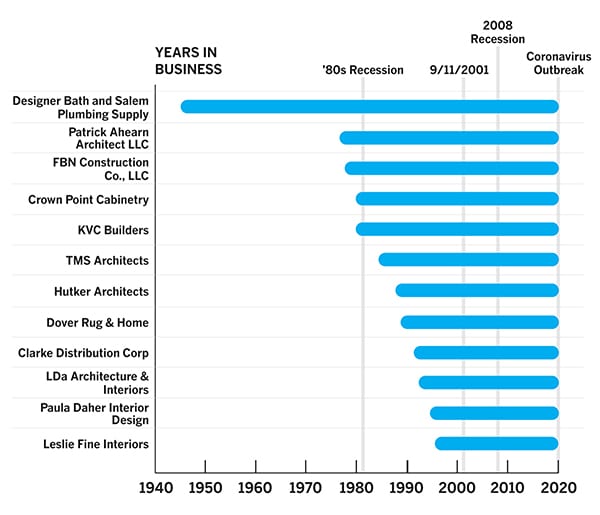COVID-19 Response: TMS Architects
April 28, 2020
We check in with twelve architects, builders, designers, and suppliers to see how they are managing their staff and their businesses during this incredibly challenging time.

With the coronavirus currently taking over our personal and professional lives, the measures that have been instituted to stop its spread have had a major impact on most businesses, including those of us serving the New England design industry. In times of crisis, we turn to people who have withstood similar circumstances in the past and persevered. We reached out to twelve industry leaders who have led their firms through past crises to share what actions they are taking now, how they will measure the success of their firms over the next twelve months, and how they’re moving forward.
Shannon Alther, Jason Bailey, Rob Carty, and Tim Giguere the principals of TMS Architects have a plan in place to weather the COVID-19 storm that mimics what they have done in other challenging times such as after 9/11.
How are you communicating with your in-house teams and outside vendors?
In early March, we had a review with our management team on steps needed if remote working was to happen. A draft plan was set into place with the ability to implement quickly. We’ve been remotely working since March 16 with a variety of apps that allow for our entire team to remain connected and converse from our homes. Communication by way of using various apps such as Slack, Zoom, regular phone/cell lines. These apps allow our management team to see who is working /not working at any point in the day. The apps also allow for some random and fun communication recreating the water cooler aspect online. We have strong communication with staff, clients, and contractors on a weekly basis or even every other day. Communication amount/frequency is aligned with the project type and current design or construction status.
How are you thinking about cash flow management differently now than in more normal times?
We review cash flow, project status, and other business operational data to make day-to-day decisions but to also look out one to two weeks for forecasting three to five weeks out. We try to understand government incentives and options that are currently in play and use them if possible.
How will you be defining success in three months, six months, a year?
Success in three months will mean a break-even business scenario and maintaining pre-virus staff. Success in six months will equal break-even or positive-profit outline and maintaining pre-virus staff as well as acquiring new projects to maintain business goals and staff workflow.
Success in one year will mean making it through this event with a stronger staff, business, and clients, and maintaining pre-virus staff.
Are there different cost-saving strategies you are leaning on regarding staff, overhead, and discretionary spending?
Cash flow management is under the microscope to verify current and two-to-three-week-out forecasting
- Verify all bills/receivables against current and future forecasts
- Maintain some flexibility in collection/invoicing
- Understand that things will change week to week
- Understand all business budget line items and which ones can or cannot be adjusted
- Know the tolerance factors for making or not making decisions
- Be willing to make decisions as needed and quickly
How do you ensure your “all of a sudden” remote workforce remains motivated and productive?
Constant communication with staff-wide video calls to inform/update everyone
-
- Do not sugar coat it
- Understand that things will change week to week
- Understand all business budget line items and which ones can or cannot be adjusted
- Know the tolerance factors for making or not making decisions
- Be willing to make decisions as needed and quickly
- Be honest and upfront
- Ask for questions/concerns to then review/discuss as a group
- Additional “management group” video calls for more sensitive information review
- Daily check on staff hours and billable time
- Review weekly hours and weekly efficiency ratio (total hours that can be worked versus actual hours worked)
- Address issues that are coming up on a weekly or daily basis (depending on the issue)
- Know that it will take longer than anyone knows and plan accordingly
- Be flexible
I hope the above outline helps. This is our snapshot of what we are doing and mimics what we did for 9/11 and 2008. Although this is a much different event with larger-scale implications; it will easily rival anything that has come before us in our lifetimes.
Share
![NEH-Logo_Black[1] NEH-Logo_Black[1]](https://b2915716.smushcdn.com/2915716/wp-content/uploads/2022/08/NEH-Logo_Black1-300x162.jpg?lossy=1&strip=1&webp=1)










You must be logged in to post a comment.